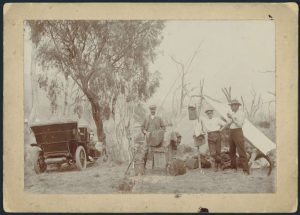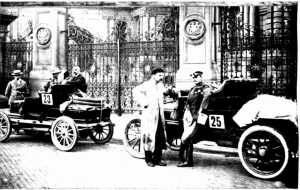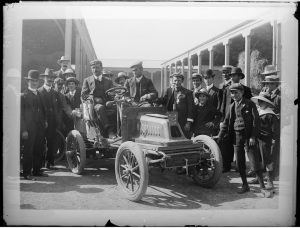The Colonel, the Poet and the Motor Car

J.M. Arnott, chauffeur and Banjo Paterson, Jindabyne c.1910.
Image courtesy National Library of Australia
John Mclean Arnott (left) of Birnam Wood, Strathfield, Managing Director of Arnott’s Biscuits, and poet, Banjo Paterson (right) shared a love of horses and cars. Here they are pictured in Jindabyne with Arnott’s chauffeur in about 1910. A veteran of the Boer War, John Arnott would later serve as a colonel during World War I.
In February 1905 Arnott took part in Australia’s first long-distance car event, the Dunlop Reliability Trial from Sydney to Melbourne along the old ‘coach road’, now the Hume Highway. Banjo Paterson reported on the event for the Evening News from the ‘comfort’ of Arnott’s car, a 20-h.p Innes. John Arnott’s brother, Dr H.R. Arnott also took part in his 9-h.p Innes vehicle.
It was an ambitious enterprise. In early 1905 there were fewer than 200 motor vehicles in Australia and our roads had not been ‘built’ for cars. As Paterson wrote in the Evening News of 20 February 1905:
‘Ruts and loose metal, sidelings, and sand-drifts, washed-out creeks and heart-breaking hills – these are the items on the bill of fare before the cars that start on the reliability trial to Melbourne tomorrow. If an English or French automobilist were told that a ‘reliability’ trial in Australia consisted in running 600 miles in five days on a main public road between two capital cities, at sixteen miles an hour, running time, if he were told that this constituted a ‘reliability’ trial, he wouldn’t see where the ‘trial’ came in.’
Banjo Paterson also composed a poem in honour of the race titled The Lay of the Motor Car.
The poem begins:
We’re away! and the wind whistles shrewd
In our whiskers and teeth;
And the granite-like grey of the road
Seems to glide underneath;
As an eagle might sweep through the skies,
We sweep through the land,
And the pallid pedestrian flies
When he hears us at hand.
We outpace, we outlast, we outstrip.
Not the fast-fleeing hare.
Nor the racehorses under the whip,
Nor the birds of the air
Can compete with our swiftness sublime,
Our ease and our grace;
We annihilate chickens and time,
And policemen and space.
The first two verses appeared in the Evening News of 20 February and must have been written before the race began. A later verse was added.

Victorian competitors waiting for the start of the race outside Sydney Town Hall.
The Sydney Mail and New South Wales Advertiser 22 February 1905 p.475
https://trove.nla.gov.au/newspaper/article/164032633
On 21 February 1905 a trail of paper was laid from Sydney Town Hall to Ashfield to assist visiting motorists to find their way out of town. Several hundred people turned up before dawn to see the motorists off. The first night was spent in Goulburn – for those who made it that far. A number of motorcyclists also took part. Cars were assigned to the ‘heavy’ or ‘light’ class and 23 motor vehicles began the race, with 17 finishing in Melbourne. Among them was the only female driver, Florence Thomson.
The aim of the trial was to foster motoring in the Commonwealth by demonstrating what the modern motor vehicle could do on rough Australian roads. The trip was eventful for many of the competitors, with countless unscheduled stops along the way to fix – or attempt to fix – various mechanical problems. The accepted attire seemed to include breeches and gaiters, high-peaked cap, white macintosh, awful goggles and sometimes a mask with a false leather nose! Scenes of Wacky Races perhaps.
Arnott’s car performed well on the whole with Paterson noting that ‘J.M. Arnott’s big Innes car passed all the small cars on the hills, and as she is fitted for touring and carries three passengers and a lot of luggage, it is a good performance for the Sydney-owned haste wagon.’
Gundagai to Albury was particularly tough. Two of the four cylinders of J.M. Arnott’s car ceased working. The rest of the day’s leg involved driving through a dust storm. As Paterson noted: ‘The French driver, who knows no English but the two words “bad road” – was asked how our glorious highways struck him. He said there are no roads in all France anything like as a bad as what we saw here, but there are some in Scotland nearly as bad, which is rough on Scotland.’
Arnott and Paterson almost came to grief near Tarcutta, NSW. After taking a wrong turn they attempted to cut across a field, hitting a drain and losing a wheel. They limped into Melbourne just in time to hear the end of the speeches. During the five-day trip J.M. Arnott managed to average 15 miles per hour.

Probably Syd Day in his 8 h.p. De Dion, entrant no.3 in the Light Car Section of the first Dunlop Reliability Trial between Sydney and Melbourne, February 1905.
Image courtesy State Library of Victoria
Banjo Paterson wrote nostalgically about the event 34 years later for the Sydney Morning Herald commenting that ‘trial’ was exactly the right word for the 1905 event.
Only one Innes car is known to have survived and been restored. It is thought to have belonged to the Arnott family. Could it be the one in the photo of Colonel Arnott and Banjo Paterson? The car was rebuilt by motoring enthusiast Geoff Simmons in about 2009.
by J.J. MacRitchie
Local Studies Advisor
References
Examiner (Launceston, TAS) 24 April 1935 p.5 https://trove.nla.gov.au/newspaper/article/51928982
Evening News 20 February 1903 p.3 https://trove.nla.gov.au/newspaper/article/112751801
Evening News 23 February 1905 p.6 https://trove.nla.gov.au/newspaper/article/112750887
Evening News 24 February 1905 p.6 https://trove.nla.gov.au/newspaper/article/112752255
Evening News 25 February 1905 p.4 https://trove.nla.gov.au/newspaper/article/112751090
Sydney Morning Herald 18 February 1939 p.21 http://nla.gov.au/nla.news-article17544194
https://allpoetry.com/The-Lay-of-the-Motor-Car
https://graham64.wordpress.com/tag/dunlop-reliability-trial/
https://www.drive.com.au/motor-news/restored-to-former-glory-20100317-qgi8
For more motoring history see also:
https://primotipo.com/tag/decauville-car/
Banjo Paterson: http://underthelino.blogspot.com/2018/02/banjo-paterson-and-history-of-haste.html
Fawbert, Jennifer. G. P. Innes (1863-1936): Pioneer of the Motor Industry https://static1.squarespace.com/static/55891778e4b034e58f5e51e7/t/590321352e69cf7ece0c69fd/1493377342299/FINAL_Jennifer+Fawbert+Mar03.pdf
